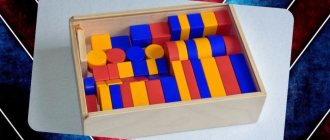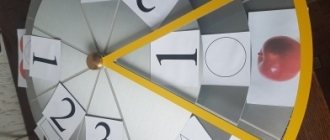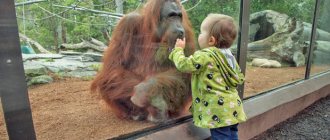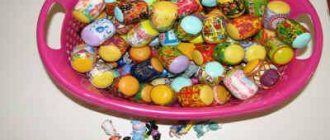The syllabic structure of a word is the order and number of syllables in words. The syllabic structure of a word refers to phonemic representations; it is the rhythmic construction of words in the native language. As a child grows up, he gradually learns to feel the rhythm of words on an intuitive level. Children with speech underdevelopment (FFSD, OSD) have difficulty mastering the syllabic structure of words; they need special remedial pedagogical training. Preschool children need to be presented with all the material in a playful, interesting form; for this purpose, special games have been developed to form the syllabic structure of words. To make it easier for a child to learn the structure of a word, the teacher needs to involve as much motor activity as possible, since with movement the child will better consolidate speech material. Words of different syllabic structures can be clapping, tapping, jumping, stepping away, and so on. 1. Pyramid game
Place a pyramid in front of the child, discuss it, then take it apart, and start putting on the rings, pronouncing words of different syllabic structures.
It is necessary to pronounce a syllable for each ring. 2. Playing with buttons
Invite your child to play with buttons, go through them, select buttons of different colors and sizes.
After sorting through the buttons, together with your child, lay them out in a row, pronouncing the words, one syllable for each button. The child should see the composition of the word, after you collect the word, repeat it again, and put the buttons collected in a row separately from the others, then discuss how you collected a lot of words, how well done you are! 3. Playing with balls
Let your child play with various small balls, leave them or roll them.
After this, invite the child to throw balls into the basin, pronouncing the words syllable by syllable. Practice this exercise with your child, gradually increasing the distance to the pelvis into which you need to throw the balls and the syllable structure of the spoken words. 4. Playing with a matryoshka
Together with your child, play with a matryoshka, disassemble and assemble it.
Then disassemble and assemble each small nesting doll separately and arrange the toys in a row, pronouncing the words syllable by syllable - for each toy one syllable. 5. Playing with geometric shapes
Invite your child to study the shapes: circle, square, triangle.
Separate all the figures into separate piles. Then, together with your child, lay out the figures in a row (for example, only circles) and pronounce the words syllable by syllable, for each circle a syllable. So play with all the figures. Then discuss with your child the number of words spoken and their length (words with one syllable are short, words with many syllables are long) 6. Playing with cubes
Take the cubes, build a tower or fence out of them, then invite the child to talk and pronounce the words syllable by syllable. , arranging the cubes in a row with a “fence”, one syllable for each cube.
7. Playing with children's seals
An adult invites the child to make a beautiful picture and gives him a seal. In a joint activity, adults and children print pictures in a row, pronouncing words syllable by syllable. For each printed picture - one syllable. Words printed syllable by syllable should be located separately from each other on a sheet of paper. Next, I bring to your attention speech material for practicing syllable structures of various levels of complexity. 1.SGSG Owl Zebu Scythe Goat Canopy Hay Notes Cinema Puma Coffee Winter Tody Melon Kiwi Sneakers Children Feet Veil Moon Water Cotton Foam Sky Flour 2.SGSG House Cat Kom Copper Fur Moss Ointment Whale Juice Catfish Network Shadow Nose Poppy Horse Dream 3.SGSGS Bison Fennec Pheasant Hamster Pig Python Banana Coconut Wagon Scoop Sock Lawn Scoop Boot Wreath Broom 4. SGSSGSG Dates Viper Cockatoo Navaga Kimono Domino Kiwano Dog Dishes Paper 5. SGSSGSG Panda Mango Pacifier Bag Folder Jar Semolina Casque Salmon Bongo Nandu Cap Sleigh Pasta Letter Dough Dachshund Discs Mask Board Bowl Bows 6. SSGS Gnome Snow Light Laughter Wardrobe Whip Sign Stack Stingray Steppe 7. SGSGSGSG Button Wolverine Pasta Turtle Spindle Pyramid 8. SGSGSGSG Scooter Shop Hippo Boot Flywheel 9. SGSGSGSGS TV Bicycle
Didactic games for the preparatory group of kindergarten
Didactic games to develop the syllabic structure of words.
Author: Budilova Galina Evgenievna, teacher, secondary school 821, preschool department.
Didactic games are intended for children in the pre-school group. Game No. 1 “Syllable Dominoes”.
For the game we will need colored cardboard, object pictures, glue, scissors, and a simple pencil. We take colored cardboard, draw the reverse side of the colored cardboard into rectangles measuring 5x10 cm.
We cut the lined sheet of cardboard into cards.
We cut out small subject pictures from old books and paste them on the colored side of the card, two at a time (left and right).
Purpose of the game: to strengthen the ability to divide words into syllables. Exercise children in determining the number of syllables in a word; in comparing the syllabic structure of various words; select pictures whose names have the same number of syllables. Develop speech, thinking, attention, phonemic hearing. Progress of the game: the child is asked to look at the cards - dominoes and lay out a chain of dominoes so that the number of syllables of the next word - name coincides with the number of syllables of the previous one. If the task is completed correctly, the chain will be closed, that is, the syllable structure of the name of the next picture will coincide with the syllable structure of the first.
Game No. 2 “Flower Shop”.
To make the game we will need postcards, colored cardboard, glue, scissors, and a pencil. We take colored cardboard, and on the back side we draw the cardboard into rectangles measuring 14x10 cm.
Cut the cardboard into rectangles.
We glue flower cards onto the colored side of the cardboard rectangles.
We take cardboard of a different color, draw the back side of the cardboard into rectangles measuring 3x8 cm.
Cut the cardboard into cards.
Glue circles on the colored side of the cards (1, 2, 3, 4).
Purpose of the game: to consolidate the ability to divide words into syllables, to consolidate the names of colors in the children's dictionary. Develop speech, thinking, attention, phonemic hearing. How to play: Place cards with flowers on the typesetting canvas. The teacher says: “This is our flower shop, it sells different flowers. Some have short names, for example: peony; others with long names, for example: forget-me-nots. You each have a number card with circles. This is money". You will be the buyers, and I will be the seller. The buyer can only buy that flower whose name has as many parts (syllables) as there are circles on the card. You will come to the store, present a number card and say the name of the flower in parts. If you correctly determine which flower you can buy, you will receive it; if you are wrong, the flower remains on the counter.” At the end of the game, the teacher shows a number card and asks to name the purchased flowers, the names of which have as many syllables as there are circles on the card.
Game No. 3 “Three Lines”
For the game you will need colored cardboard, object pictures, scissors, glue, pencil. Take a sheet of cardboard and divide it into three parts.
We take another sheet of cardboard and draw it on the reverse side into squares with a side of 5 cm.
Cut the cardboard into squares.
We paste object pictures onto the squares.
Purpose of the game: to train children in dividing words into syllables; determining the number of syllables in a word; find pictures whose titles have a certain number of syllables. Develop children's speech, cultivate attention and thinking. Progress of the game: children are given large cards, divided into three parts and subject pictures. Children should place pictures on the first line whose names consist of one syllable; on the second line put pictures whose names consist of two syllables; on the third - of three syllables.
We recommend watching:
Didactic game with sounding objects for older preschoolers Didactic game for teaching literacy to older preschoolers Didactic game for teaching literacy to older preschoolers Lesson on speech development in the preparatory group. Spring
Similar articles:
Summary of an integrated educational activity in the preparatory group of children with a compensatory orientation “Visiting Winter”
Story-based didactic game for older preschoolers “We are traveling on a train”
Didactic games to familiarize yourself with flora and fauna for children of the senior preparatory group






